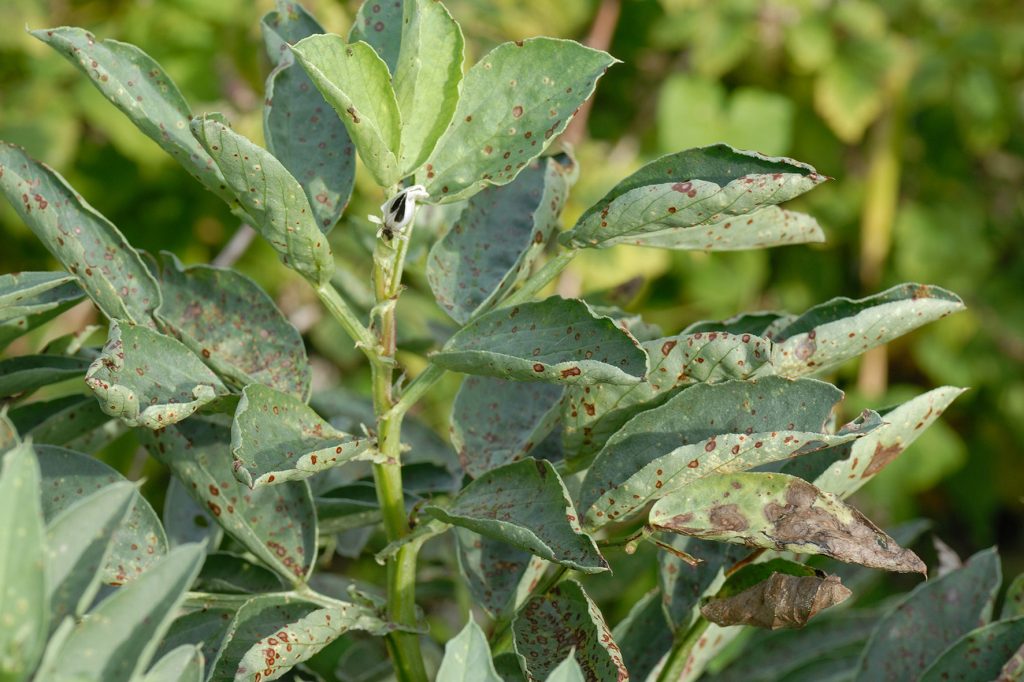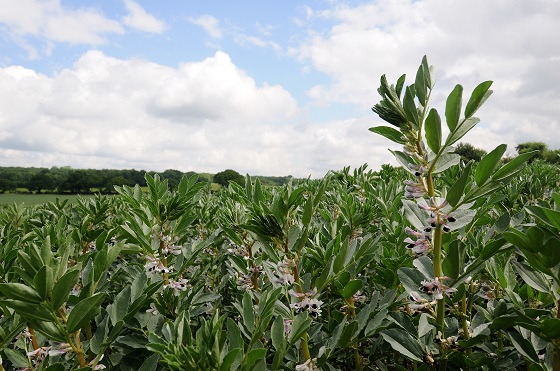Pulse agronomy highlighted on PGRO Roadshow
21st February 2018
The PGRO Roadshow, in association with Syngenta, has been working its way across the country, offering an insight into the crops’ latest market outlook and agronomy developments to over 250
The PGRO Roadshow, in association with Syngenta, has been working its way across the country, offering an insight into the crops’ latest market outlook and agronomy developments to over 250 growers and agronomists.
Root rot on the move
Despite being identified in the UK, in Scotland, only around 30 years ago, the root rot fungus, Aphanomyces, is now endemic across most pea growing areas. Nearly 70% of fields tested when showing foot rot, had Aphanomyces present.
Brian Ó Loinsigh of Nottingham University reported yield losses of pea crops on foot rot affected field patches were typically 40 to 85%, but could result in total crop failure. Focusing on field areas displaying foot rot problems, his PhD project found that 50% of them had infection levels indicating peas should not realistically be grown in the rotation for the next 10 years.
For a soil borne fungus that is not spread by wind or rain splash it’s a remarkable movement, possibly with infected soil carried on machinery between fields and farms, he believed. Aphanomyces euteiches appears capable of surviving as oospores for up to 10 years in the soil, aided by a wide number of weed species that will host and perpetuate infection. There is no evidence that the infection can be spread on seed, he pointed out.
The impact can be further compounded in compacted soils, in part because they are typically wetter and conducive to the fungus, but also because peas tend to put out more side roots in such conditions – which are particularly targeted by the pathogen. Infection also makes crops susceptible to nutrient and drought stresses, as well as other complex diseases such as Fusarium, for example.
With no treatment or varietal resistance available, Mr Ó Loinsigh advised the current best option is to improve soil conditions and establishment techniques, so that peas can quickly develop faster, bigger root structures, and longer rotation intervals. Healthy growing plants can withstand low to moderate infections of Aphanomyces, he pointed out.
The Nottingham University project, supported by the PGRO, could also see the development of soil testing bioassay techniques to identify and quantify the level of soil infection, to enable better informed decisions on rotations and cropping options.
Environmental attraction
Environmental initiatives that look set to become an increasingly significant part of all farming systems could deliver both agronomic and ecological benefits, according to Dr Max Newbert, Syngenta Field Technical Specialist.
Syngenta Operation Pollinator research, in conjunction with ASDA, had demonstrated clear improvements in soil protection and structure, along with the opportunity to reduce leaching, with areas sown using a Green Headland seed mix alongside crops, he reported.
The Green Headland mix, incorporating vetches, clover, phacelia and radish, generated 36 tonnes/ha of green organic matter, including capturing 106 kg N/ha, to help improve soil structure and fertility, he reported.
Insect monitoring of the ecologically enhanced sites in 2017 sampled 25,000 invertebrates, with 188 species. Of those, 56 species were identified as being positive pollinators for crops and 53 species known to be predators of crop pests.
Furthermore, there were no aphids caught from the headland areas in any of the sampling timings. Dr Newbert pointed out that since aphids lose the capability to transfer non-persistent viruses very quickly, the Green Headland areas could potentially act as a barrier to reduce their spread into crops.
Studies by the Centre for Ecology and Hydrology, and reported by the Campaign for the Farmed Environment, has highlighted that integrating environmental management alongside commercial farming could enhance overall farm productivity and profitability – with beans the crop that benefitted most from increased pollination and natural predator pest control.
“For bean pollination you want to encourage long-tongued species of bumblebees that are more effective at working in the flowers; short-tongued bees tend to bite through the underside of the flower to rob the pollen – without the benefit of pollination.
“Insect monitoring on farms with Operation Pollinator mixes have shown that a high proportion of Berseem and Red Clover has been particularly attractive for long-tongued bumble bees,” he added.
Future pest control
New developments in insect pest control could see future options so specific that individual species can be targeted, whilst leaving beneficial pollinators and predators completely unaffected, reported Max Newbert.
Syngenta R&D using genetic coding RNA technology can potentially design an effective insecticide for any specific target pest species, such as the Pea & Bean Weevil or Bruchid Beetle. The naturally occurring RNA biocontrol targets the pest’s messenger pathway between its DNA and protein production in the cell – and since it’s specific to the RNA nothing else is affected.
RNAI products are already in advanced field trials for pests in Latin America, applied as conventional sprays with no crop phytotoxicity issues and formulated to aid good stability for lasting results. Although there is no timescale for European pest products, Dr Newbert believes they could become an integral part of an IPM programme within the next decade.
Pulse potential
Pulse crops continue to offer significant benefits to whole-farm crop rotations, which more than outweigh changes under EFA rules and ensure they retain a viable role, according to PGRO Chief Executive, Roger Vickers. He cited cropping figures indicate little change in the bean area with winter plantings.
However, he pointed out the experiences of harvest 2017 have highlighted the need for growers to focus on quality production. Just 15% of peas achieved the top quality bracket and a higher proportion destined for animal feed market, whilst Bruchid damage in the south and wet weather rain staining in the north had adversely affected bean quality.
The lucrative export market for human consumption beans had been at only 50% of normal levels, however the weak pound had aided export of feed beans that had increased significantly this season.
Mr Vickers highlighted growing market segments for pulse flour millers, with new facilities in East Anglia, along with increasing demand for pulse protein in health and sports nutrition markets, along with pulse snack foods.
“Pulse crops tick all the boxes for sustainable food production, and the delivery of public goods for a healthy diet and positive environmental contribution. In terms of profitability of the whole farm rotation, pulses should play a key part in future agri-policy,” he said.
Against this positive outlook, the ongoing issue of reduced crop protection options remained a significant threat to producing quality crops for premium markets, he added.
Early start for bean protection
Starting the bean disease control programme in April can protect the green leaf area right through the season and give significant yield increases over conventional fungicide programmes.
Syngenta Vegetable Field Technical Manager, Simon Jackson, reported two years of replicated trials with Amistar applied at the end of April to target initial Mildew infection in winter beans – mid-May in spring sown crops – have further boosted control of Rust and resulted in less Chocolate Spot later in the season, compared to typical two-spray programme with Alto Elite.

Chocolate spot on beans.
Most strikingly, improved crop health all season resulted in crops retaining over 90% of peak green leaf area through July, compared to 71% with the standard two-spray programme and just 30% in the untreated crop.
The increased photosynthetic activity and health of the crop achieved an average 0.35 t/ha yield increase over the standard programme from adding an extremely cost-effective early Amistar treatment, pointed out Mr Jackson. If mildew had been severe at the time of the early treatment, however, SL567A would likely be the preferred option.
Bean row width
On-going establishment trials by the PGRO have shown that planting at 25-30cm row width appears to be the optimum for spring beans crop yields, reported researcher and trialist, Steve Belcher.
Increasing to wider row widths, of 30-35 cm, has consistently seen yields fall away, he said. “But if growers are using wider row widths to fit with farm systems, the trial results indicate they do need to moderate plant populations to avoid inter-row competition – with 40 plants per m2 (ppm2) proving more consistent than at 60 ppm2.”
Mr Belcher pointed out that growing spring beans at 40 ppm2 in 15 cm rows would, theoretically, give the most equidistant plant spacing, however, yields have consistently proven lower than at the 25-30 cm width with plants closer together in the row.
The most recent trials had also included sowing two rows together at 15 cm and then a 30 cm gap, to more closely replicate some on-farm direct drill placement; the results of which were a lower yield, compared to sowing at a consistent 25 cm row width to achieve the equivalent plants spacing.
He added beans should now be best drilled at 50-75 mm depth, since they no longer need the soil coverage to protect from simazine pre-emergence herbicide treatments. Providing seed is place below rook pecking depth and can develop the roots to avoid being easily pulled out, shallower drilling will ensure faster and more even emergence.

